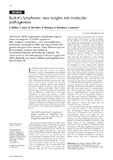| dc.contributor.author | Nyong`o, A | |
| dc.contributor.author | Bellan, C | |
| dc.contributor.author | Lazzi, S | |
| dc.contributor.author | De Falco, G | |
| dc.contributor.author | Giordano, A | |
| dc.contributor.author | Leoncini, L. | |
| dc.date.accessioned | 2013-06-10T07:14:12Z | |
| dc.date.available | 2013-06-10T07:14:12Z | |
| dc.date.issued | 2003 | |
| dc.identifier.citation | J Clin Pathol. 2003 Mar;56(3):188-92 | en |
| dc.identifier.uri | http://www.ncbi.nlm.nih.gov/pubmed/12610094 | |
| dc.identifier.uri | http://erepository.uonbi.ac.ke:8080/xmlui/handle/123456789/30414 | |
| dc.description.abstract | The World Health Organization classification reports three subcategories of Burkitt's lymphoma (BL)--endemic, non-endemic, and immunodeficiency associated--proposed to reflect the major clinical and genetic subtypes of this disease. These different types of BL have been reviewed and studied by immunohistochemistry and molecular methods. The results point out the heterogeneity of BL and suggest that AIDS related BL may have a different pathogenesis from that of classic BL. | en |
| dc.language.iso | en | en |
| dc.publisher | University of Nairobi, | en |
| dc.title | Burkitt's lymphoma: new insights into molecular pathogenesis. | en |
| dc.type | Article | en |
| local.publisher | Institute of Pathological Anatomy and Histology, University of Siena | en |
| local.publisher | Department of Human Pathology, College of Health Sciences, University of Nairobi, Kenya | en |


